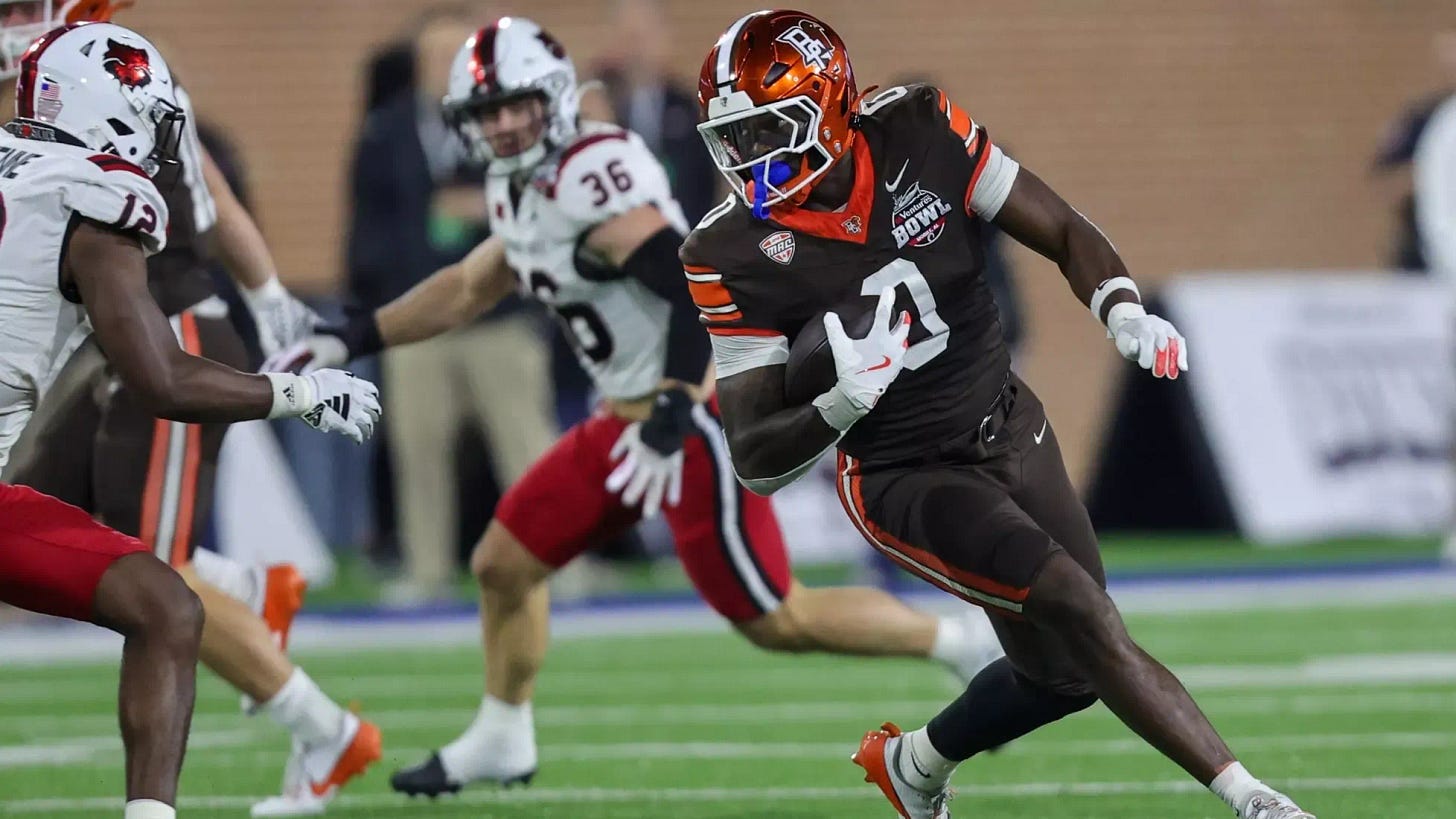Harold Fannin Jr. is everything and nothing like a tight end
He’s too stiff. Too slow. Too… effective? Harold Fannin Jr. is an enigma— and yet he might be the NFL draft’s most quietly dangerous offensive weapon.
He’s 6-foot-3, 241 pounds of the unconventional. Of confusion. Of contradiction. A tight end with a smaller frame, a power slot who isn’t fast by any means. A record-breaking pass catcher with the gait of a teenager playing backyard football.
Harold Fannin Jr. is one of the NFL draft’s mysteries this year.
In an era where tight ends are finely tuned chess pieces — 6-foot-6 red zone skyscrapers, inline bulldozers, or Kyle Pitts-shaped unicorns — Fannin is none of those. He doesn’t jump off the screen with elite athleticism. He doesn’t pancake defensive ends in the run game. His game isn’t played above the rim. It’s played in the dead zones of a defense’s awareness, where linebackers hesitate and safeties peek into the backfield. And it works.
God, does it work.
At Bowling Green, Fannin carved up the MAC effortlessly. In 2024, he led all FBS tight ends in receptions (117), yards (1,555), and touchdowns (10) and broke the single-season tight end receptions record. Sure, some were H-back dump-offs within eight yards of the line of scrimmage. Some were manufactured touches. But watch the tape: he’s also winning on choice routes, slants, and seams. Fannin was the offense. And it wasn’t just against MAC opponents, either. Fannin torched Penn State’s No. 7-ranked pass defense for 11 catches, 137 yards, and one touchdown.
His historical season wasn’t a one-off.
Down in Mobile, Ala., under the Senior Bowl microscope, Fannin had a chance to show his ability up close. To show his movement skills and his capability against non-MAC defenders. The result? He ran circles around the doubt.
He looked quick. Sharp. He had suddenness in and out of his breaks that’s more difficult to detect on tape. He still ran slightly duck-footed, but there was nuance — a snap at the top of his routes, a feel for leverage against bigger, faster defenders. And he won. Repeatedly. He didn’t dominate the highlight reels, but that’s never been the point. He played his game — subtle, spatial, unshaken — and proved that the tape isn’t a fluke. It’s not to be shrugged off. It travels.
This encapsulates the Fannin conundrum. His stride is unorthodox — upright, almost rigid. So much that it casts doubt on his ability at the next level. Yet, he moves efficiently. He separates. He finishes.
Scouts are torn about what he projects to be because, well, they are always with someone like this. Someone who doesn’t fit a category.
Some see a hybrid weapon — an NFL mismatch waiting to happen, a flex tight end who can feast in the short game and live in the seams. A H-back with strong hands and YAC ability. Others see a gadget. A MAC-made illusion who will vanish the moment NFL safeties get a read on his speed.
Yet even that question feels too small. Too binary. Fannin is what happens when you strip football of pretense, when you stop asking if a guy can run a 4.4 and start asking if a guy gets open, when you realize that maybe route polish and catch radius aren’t everything — that maybe the best receivers are the ones who understand space (e.g., Cooper Kupp, Amon-Ra St. Brown) better than the people trying to contain them.
That’s Fannin. He understands space. He understands tempo. He understands that you don’t need to be fast — you just need to arrive at the right time. Blocking isn’t his calling card. Not yet. He’s not moving defenders off their spot or owning leverage on combo blocks. But there’s a reason — and it’s not just his frame. Fannin is only 20 years old. You see it in the way he engages: the technique is raw, the timing inconsistent.
At worst? Maybe he’s Isaiah Likely, another tight end who doesn’t check the boxes but still finds a way. Likely came out of Coastal Carolina at 6-foot-4, 245 pounds — nearly identical to Fannin — and didn’t wow with testing numbers either, running a 4.82 forty at his pro day. But he understood space. He won as a receiver, posting 912 yards and 12 touchdowns his senior year, and carved out a role in Baltimore as a mismatch piece in the slot. He wasn’t a dominant blocker. Neither is Fannin. But both have that same hybrid DNA — not unicorns, not bulldozers, not burners — just guys who get open, stay open, and punish defenses that forget about them.
At the Scouting Combine, Fannin ran a substandard 4.73 forty when many, including myself, expected better. But that’s not the be-all and end-all. Watch the film. Trust your eyes. Fannin knows how to get open. He knows how to finish. He knows how to make a defense look silly and a scout look stupid.
That’s what makes Fannin so damn interesting.
Not because he’s built like Antonio Gates or moves like Travis Kelce. But because he isn’t, and he doesn’t.
Because he’s everything and nothing like a modern tight end.
Because he shouldn’t work — but he does.


